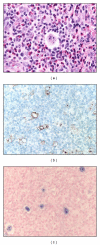HIV-Associated Hodgkin's Lymphoma: Prognosis and Therapy in the Era of cART
- PMID: 22272202
- PMCID: PMC3261478
- DOI: 10.1155/2012/507257
HIV-Associated Hodgkin's Lymphoma: Prognosis and Therapy in the Era of cART
Abstract
Patients with human immunodeficiency virus/acquired immune deficiency syndrome (HIV/AIDS) are at increased risk for developing Hodgkin's lymphoma (HL), a risk that has not decreased despite the success of combination antiretroviral therapy (cART) in the modern era. HIV-associated HL (HIV-HL) differs from HL in non-HIV-infected patients in that it is nearly always associated with Epstein-Barr virus (EBV) and more often presents with high-risk features of advanced disease, systemic "B" symptoms, and extranodal involvement. Before the introduction of cART, patients with HIV-HL had lower response rates and worse outcomes than non-HIV-infected HL patients treated with conventional chemotherapy. The introduction of cART, however, has allowed for the delivery of full-dose and dose-intensive chemotherapy regimens with improved outcomes that approach those seen in non-HIV infected patients. Despite these significant advances, HIV-HL patients remain at increased risk for treatment-related toxicities and drug-drug interactions which require careful attention and supportive care to insure the safe administration of therapy. This paper will address the modern diagnosis, risk stratification, and therapy of HIV-associated HL.
Figures

Similar articles
-
Hiv and Lymphoma: from Epidemiology to Clinical Management.Mediterr J Hematol Infect Dis. 2019 Jan 1;11(1):e2019004. doi: 10.4084/MJHID.2019.004. eCollection 2019. Mediterr J Hematol Infect Dis. 2019. PMID: 30671210 Free PMC article. Review.
-
High Risk Features Contrast With Favorable Outcomes in HIV-associated Hodgkin Lymphoma in the Modern cART Era, ANRS CO16 LYMPHOVIR Cohort.Clin Infect Dis. 2015 Nov 1;61(9):1469-75. doi: 10.1093/cid/civ627. Epub 2015 Jul 29. Clin Infect Dis. 2015. PMID: 26223997
-
Clinical characteristics of human immunodeficiency virus-associated Hodgkin lymphoma patients in Japan.Int J Hematol. 2012 Aug;96(2):247-53. doi: 10.1007/s12185-012-1127-5. Epub 2012 Jul 1. Int J Hematol. 2012. PMID: 22752537
-
Hodgkin Lymphoma in People Living with HIV.Cancers (Basel). 2021 Aug 29;13(17):4366. doi: 10.3390/cancers13174366. Cancers (Basel). 2021. PMID: 34503176 Free PMC article. Review.
-
AIDS-related lymphoma in Brazil. Histopathology, immunophenotype, and association with Epstein-Barr virus.Am J Clin Pathol. 1996 Feb;105(2):230-7. doi: 10.1093/ajcp/105.2.230. Am J Clin Pathol. 1996. PMID: 8607450
Cited by
-
NF-κB and IRF7 pathway activation by Epstein-Barr virus Latent Membrane Protein 1.Viruses. 2013 Jun 21;5(6):1587-606. doi: 10.3390/v5061587. Viruses. 2013. PMID: 23793113 Free PMC article. Review.
-
Inflammatory pseudotumor-like extranodal classic Hodgkin lymphoma manifesting as bowel perforation in acquired immunodeficiency syndrome patient with disseminated leishmaniasis: a case report and approach to differential diagnosis.J Gastrointest Oncol. 2024 Dec 31;15(6):2684-2691. doi: 10.21037/jgo-24-499. Epub 2024 Dec 27. J Gastrointest Oncol. 2024. PMID: 39816042 Free PMC article.
-
Epstein-Barr Virus in Gliomas: Cause, Association, or Artifact?Front Oncol. 2018 Apr 20;8:123. doi: 10.3389/fonc.2018.00123. eCollection 2018. Front Oncol. 2018. PMID: 29732319 Free PMC article. Review.
-
Immune Deficiency/Dysregulation-Associated EBV-Positive Classic Hodgkin Lymphoma.Cancers (Basel). 2025 Apr 25;17(9):1433. doi: 10.3390/cancers17091433. Cancers (Basel). 2025. PMID: 40361360 Free PMC article. Review.
-
Radiology examination as a diagnostic aid in presentations with wide differential diagnoses: Case report of new Hodgkin's lymphoma on a background of poorly controlled HIV.SA J Radiol. 2017 Nov 14;21(2):1239. doi: 10.4102/sajr.v21i2.1239. eCollection 2017. SA J Radiol. 2017. PMID: 31754482 Free PMC article.
References
-
- Detels R, Muñoz A, McFarlane G, et al. Effectiveness of potent antiretroviral therapy on time to AIDS and death in men with known HIV infection duration. Journal of the American Medical Association. 1998;280(17):1497–1503. - PubMed
-
- Palella FJ, Jr., Delaney KM, Moorman AC, et al. Declining morbidity and mortality among patients with advanced human immunodeficiency virus infection. The New England Journal of Medicine. 1998;338(13):853–860. - PubMed
-
- Powles T, Robinson D, Stebbing J, et al. Highly active antiretroviral therapy and the incidence of non-AIDS-defining cancers in people with HIV infection. Journal of Clinical Oncology. 2009;27(6):884–890. - PubMed
LinkOut - more resources
Full Text Sources

